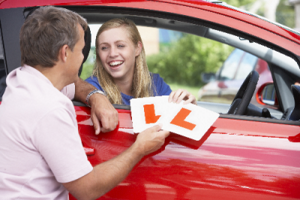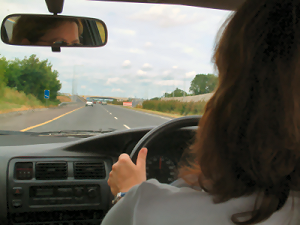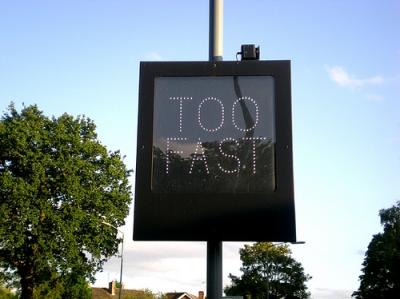
 Why ever would you want to go through the stress of teaching your children to drive?
Why ever would you want to go through the stress of teaching your children to drive?
Here are a few reasons
The Driving and Vehicle Standards Agency say that the average learner now needs around 45 hours with an instructor and a further 22 hours of additional practice.
It's a tough message but with motor accidents being the single biggest killer of young people between the ages of 17 and 24, getting the right start behind the wheel is essential.
50% of young people pass on their first test attempt – 20% crash within a year of passing the test – 1500+ young drivers are killed or seriously injured on UK roads every year.
The more experience learners can gain before the test, the higher the chance of a first-time pass. This can save money on professional lessons but far more important than this, the additional experience can help them to understand a broader range of 'road risks' than the limited time spent with an instructor would allow.
We don't intend the information in this guide to replace lessons with a professional instructor – the advice will help you to allow your children to practise what their instructor teaches.
These common-sense ideas are distilled from the extensive experience of one who, for many years, set out every morning to face death squarely in the face sitting in the instructor's seat of a driving school car!
Practising with parents is becoming more common as people move towards automatic and electric cars.
There are three main reasons why using DriverActive will help:
Practise will be better targeted
You will know that you are teaching the right information and driving methods
Your children will be better prepared for their lessons with an instructor and so will get better value from their lesson time
We mentioned gaining experience above; this is far more important than saving money on lessons. Researchers in Sweden research has demonstrated that the more practice learner drivers get at home, the safer they will be after passing the test.
The DriverActive Online Course gives you a comprehensive resource to help ensure that your child learns the correct information. This can be invaluable when resolving misunderstandings - and it's sometimes the supervisor who misunderstands!
The reasons why 1 in 5 new drivers crash in their first year
 First and foremost, before going out with a learner driver, make sure that you meet the legal minimum licence requirements. Most parents will qualify with no problem - but if sisters, brothers or friends supervise, ensure they meet the conditions below.
First and foremost, before going out with a learner driver, make sure that you meet the legal minimum licence requirements. Most parents will qualify with no problem - but if sisters, brothers or friends supervise, ensure they meet the conditions below.
The supervisor must:
Be over 21 years of age
Have held a full Great Britain (GB), Northern Ireland or European Community/European Economic Area (EC/EEA) driving licence (for the type of vehicle you are using) for a minimum of three years.
(Note: Different condition apply in the Republic of Ireland,.)
Supervisors are legally responsible for the safety of the driver and other road users - they are not passengers! There have been several cases where driving supervisors have been held liable after an accident - you could lose your licence.
Specific legal points:
It is illegal to accept payment of any kind in exchange for driving lessons (unless delivered by a fully qualified or Licensed driving instructor)
You must remain fully alert and attentive (you can't have a nap!)
You must meet the same eyesight rules as drivers (wearing spectacles or contact lenses if required)
Learners are not allowed on motorways (Unless with a fully qualified instructor in a dual-controlled car)
While supervising, you must not use a hand-held mobile phone. To do so will incur a fine and points on your licence.*
You must not use a 'tablet' or any other device that is capable of displaying moving images.*
You are governed by the same drink and drug laws as you are when driving - and could lose your licence if convicted.
* You can use a phone or tablet if the car is safely and legally parked with the engine switched off and the parking brake applied (not when stopped in traffic, for example, at a red light). Hands-free phone use is permitted but not recommended when supervising or driving.
** It can be tempting to try and save money by 'fronting' when a learner has their first car. Fronting is the term insurance companies use to describe a particular type of insurance fraud that can lead to invalid insurance. This could lead to the insurance company not paying out in the event of a claim and the supervisor ending up with a criminal record.
There is no legal requirement for a driving supervisor to have a rear-view mirror, although cars used for driving tests must have a dedicated mirror for the examiner's use.
We strongly recommend getting yourself a mirror for the supervisor's side of the car*. Take care to make sure that the mirror is not fitted where it will distract the learner or obstruct their view. Mirrors that attach to the windscreen with suction cups are readily available in car accessory shops.
*When with a learner, you will sit in the 'supervisor's seat' - there is no 'front passenger seat' when you supervise. You are not a passenger!
Mobile phone use - drivers rules apply equally to supervisors
 It's easy to think that you are a good driver because you passed your test some years ago and drive every day, but this is not always true.
It's easy to think that you are a good driver because you passed your test some years ago and drive every day, but this is not always true.
Sadly, many UK drivers would struggle to pass a basic driving test. If you are not a driving enthusiast or an advanced driving association member, it would be worth getting an assessment from an instructor or your local advanced driver's association.
A survey by Admiral Insurance found that:
"Despite many parents admitting they have picked up bad habits, the majority (53%) still think they would pass their driving test if they had to sit it today. The remaining 47% don't think they would pass."
In the same survey:
"45% of the parents surveyed said they worried they pass on their bad driving habits, while 37% of the teenagers said they thought they had picked up bad habits from their parents."
In another survey, learners reported said parents had told them, "it's OK to steer with your knees" and that they didn't have to stop at a Stop sign!
Teaching others to drive can be an excellent opportunity to take stock of your own driving. I guarantee that there will be some information in the DriverActive Learners Course you will be unaware of - or which might surprise you. For example, do you know what a 'Tiger Crossing' is? Or that it's perfectly OK to cross your hands on the steering wheel in a driving test?
Take a look at the video below. Although produced in 2013, the principles are as valid today as they were then.
 Poor route planning will lead to the learner making mistakes that are, in reality, the supervisor's fault - and you know how it goes. The learner starts complaining (stress). Mum or Dad shouts (stress), the car stalls, and everyone gets upset!
Poor route planning will lead to the learner making mistakes that are, in reality, the supervisor's fault - and you know how it goes. The learner starts complaining (stress). Mum or Dad shouts (stress), the car stalls, and everyone gets upset!
Poorly planned routes put the learner under undue stress, and it's virtually impossible to assess the driving accurately. There is a good chance you will end up arguing with your learner or another driver - and the possibility of an accident.
It will be difficult to distinguish between mistakes made because of the route 'pressure' and those that occur because of a lack of skill or understanding.
Inappropriate routes will lead to reduced motivation, slow learning and arguments!
'Route planning' sounds very grand. But it simply means keeping to the places where the driver feels comfortable when practising.
Better still, ask for the driving instructor's advice, sit in the car during a driving lesson - or attend a 'supervisors class' if your local driving instructor is enterprising enough to offer this service.
Another problem with unsuitable routes is that many of the other drivers you encounter will be unforgiving of a car displaying 'L' plates. While there is an ever-present risk of 'road rage' in these situations, perhaps the most significant problem would be the negative feelings of the learner (embarrassment after stalling, for example) which will zap confidence.
 For driving sessions to be of value, both you and the person you supervise need to be as relaxed as possible.
For driving sessions to be of value, both you and the person you supervise need to be as relaxed as possible.
Finding time for practise might take a little planning. Be careful that you don't make promises that you will struggle to keep, or you might find that the practise doesn't go well.
For example, you promised a practise session mid-week evening but don't factor in that you are likely to be tired after a day at work. This can lead to a row with your teenager if you decide to cancel or problems during the drive if you are tired. Problems include being unaware of things on the road and possible irritability.
In the early stages of learning, you will need dedicated sessions in very quiet areas to allow the learner to master basic control and road procedure routines. However, as their skill develops, you can use regular journeys to provide extra practise - a drive to the shops, to visit relatives and so on. The important thing is that the learner is ready for the challenges that the practise route will present and allows enough time for the journey.
Avoid very busy times of the day until the learner is nearing the driving test standard. With this in mind, take advice from a professional driving instructor to determine what that standard is.
Practise will be valuable in all weather conditions and at different times of the day. But before practising in severe weather conditions such as snow, torrential rain, fog, etc., it's worth checking with a professional instructor to ensure your learner is ready for the challenge. Some learners never get an opportunity for lessons after dark with their instructor - you can provide this practise at home.
 The critical word in the title above is 'practise'.
The critical word in the title above is 'practise'.
This guide started by saying that it is not designed as a replacement for professional driving lessons - it's intended to supplement those lessons and provide your learner with a deeper and broader range of experience over more hours than would usually be practical with a professional instructor.
With the above in mind, it's not usually a good idea for parents to teach new subjects before a driving instructor has covered them. Driving instructors are 'up to speed' with modern driving theory, vehicle design, rules and regulations - and the things that have changed since you learned to drive. For example, when did you last look at The Highway Code? Did you know that there were almost 100 changes to the Highway Code between 2015 and 2021 and a major update in 2022?
Ask your son/daughter's driving instructor for advice about what to practise between driving lessons.
Suppose, for any reason, your children are unable to have regular lessons (financial hardship, living in a very remote location, etc.). In that case, the DriverActive Course offers you a syllabus that follows the' approximate 'path' most learners would follow. Starting with basic control skills (Early Skills), moving through road procedure (Road Skills) and then moving on to more complex skills (Using Your Skills).
Although extremely important, car control forms only a tiny part of driving and learning to drive. As we move towards automatic, hybrid and electric cars, car control is becoming an even smaller part of the learning process.
The most important part of learning to drive is learning about 'self-management' and 'how to deal with' other road users, and 'to think through' new situations.
The best value you can give your learner in reducing road risk and staying alive lies in helping them learn from their experience during practise sessions – discussion and reflection are as important as driving practise, often more important. Talk about things that happen during the drive.
A typical example might be if another driver 'cuts you up'. It doesn't help your kids if you say, "look at that idiot". Even worse if you wind down the window and 'have a go' at the other driver. These actions teach your child to become combative, distracted, and angry behind the wheel. 'Angry' is not a good emotional state for safe driving.
Maybe the driver who cut you up is an 'idiot'. If so, it's doubtful they will learn anything from your (angry) words of wisdom.
Maybe they are rushing to a hospital bedside to be with a dying loved one?
Maybe they just made a mistake?
Whatever the reasons for the actions of other drivers, your kids need to understand that it is not within their control to 'deal with' or change them. To stay safe from physical attack or heightened risk of crashing, they must learn to protect themselves by developing a defensive attitude.
This aspect of learning to drive starts long before your children are old enough to get behind the wheel.
Research has shown links between the driving style of parents and that of their children. Things like speeding or talking on the phone while driving are behaviours young adults are more likely to copy, especially if parents have normalised them.
Bad driving habits are dangerous at any age - but the same bad habits that might end up with a near miss or minor bump for an experienced driver can result in a fatal accident or life-changing injuries for a new driver.
Finally, allow your son/daughter to practise driving with 'safe' distractions. These can include:
Driving with music/radio on
Driving with friends/relatives as passengers
Driving with pets in the car
Many learners never get this kind of experience because most of their learning is with a driving instructor when in-car distractions are minimal. Dealing with everyday distractions is essential for safe driving.
Advice from 'Young Marmalade' insurance
Blog post from 'Happiful Hacks'
Survey revealing difficulties when parents teach children
You will also find driving information in the DriverActive Driver's Area
 The most common driving problem I have seen over thousands of hours sitting in the back (and front) of driving school cars is that new drivers approach most situations too fast.
The most common driving problem I have seen over thousands of hours sitting in the back (and front) of driving school cars is that new drivers approach most situations too fast.
This would suggest that, when learning a hazard routine, not enough emphasis has been placed on the importance of the simple principles, 'speed before gear' in a manual car or 'speed before steering' in an automatic or electric vehicle. In these situations, you will hear learners saying that "There isn't enough time to think of everything".
You could be doing more harm than good when sitting next to your novice driver if you are not entirely familiar with the basic 'Mirrors Signal Manoeuvre' process (including 'Position, Speed and Gear'). It then costs extra time and money for professional tuition to sort out any problems.
If a basic hazard routine is not habitual, all sorts of problems will arise later in training. To avoid the speed problem, start by using the routine at slow speeds and then build up to average driving speed with practice. You can learn more about using a hazard routine in various driving books or the DriverActive online course.
Always be aware that the learner you are with will often not respond as quickly to situations as you do and may need to drive a bit slower to compensate.
 The words you use can make a massive difference to how your learner responds (or doesn't respond!).
The words you use can make a massive difference to how your learner responds (or doesn't respond!).
Terms such as 'gently', 'slowly', 'carefully', and so on have different meanings to different people.
When giving instructions, you should always explain what you mean. Doing this will prevent problems caused by misunderstandings.
An example might be saying, "Drive at 20 miles per hour" - this would be much clearer than saying, "Drive slowly".
Also, focus on the action required rather than on the desired result. If your learner panics when approaching a traffic light or other situation, screaming, "Slow Down!" is unlikely to help. "Press the foot brake" might be more helpful! Equally important is to focus on the positive - "Don't go too near to the parked cars" puts attention on the parked cars and increases the likelihood of the driver getting close. "Keep well towards the centre of the road and look well ahead" takes attention away from the parked cars and is more likely to have the desired effect.
If you want your driver to park, it's safer to say something like "Pull up on the left" rather than "Stop on the left". This is because the word 'stop' can be taken literally, leading to a sudden stop. If the learner is stressed or nervous, they may respond to the word 'stop' before you finish whatever else you intend to say.
Ensure you give directions early enough for the driver to take action. Remember that they might take a little longer to act than you do yourself.
Take care with the word 'right' in general instruction. "I want you to turn left, right?" - could be very confusing when the learner is trying to remember where the indicator switch is, deciding how much to slow down and silently praying that the car coming towards them will stop!
Another potentially hazardous instruction is "Go straight on". Again, this can be taken as direct instruction - as this author discovered two weeks into his driving instruction career. I gave the instruction to "Go straight on" at a crossroad - my learner completely ignored the Stop Line and shot across the junction before I could take action. Luckily the road was clear. I've heard of learners driving through red lights in similar situations.
 The 2020 Veygo Learner Driver Report stated that the most common cause of friction when learning to drive with friends or relatives was a simple breakdown in communication, with 14.7% citing it as a cause of arguments. It also says:
The 2020 Veygo Learner Driver Report stated that the most common cause of friction when learning to drive with friends or relatives was a simple breakdown in communication, with 14.7% citing it as a cause of arguments. It also says:
"Another downside of learning with a friend or family member is that they're not as likely to show as much patience as a professional, as we can see through the fact that 11% of people would end up having arguments over mistakes that they made while learning."
Following the advice in this short guide will go a long way towards avoiding any communication problems. The driving information at DriverActive will help ensure that you teach the right things.
If you spend a lot of time trying to prevent your learner from stalling or hesitating at junctions, frightening you with their speed, or a myriad of other issues, the most likely reason will be that you are in the wrong place at the wrong time. This compounds any communication issues:
You will get nervous, and the language you use will tend to be 'panicky' and lack important detail
The learner will be nervous, and they will not hear some of the things you are saying (shouting doesn't help!)
As we mentioned earlier, unless your learner is nearing the 'driving test standard' (as certified by their instructor), it's inadvisable to venture onto busy roads in heavy traffic.
Don't be misled by the fact that the learner you supervise can drive for miles on country roads, or main roads out of town, without incident. The skills needed on these roads are minimal compared to the skills required in town and are certainly not enough for town traffic or the driving test.
A typical issue with many learners is that insufficient time is spent on early lessons when the learner is mastering essential control on quiet roads (or off-road areas). Sitting with your son or daughter as they practise in quiet areas might be boring, but this basic 'control consolidation' is essential - especially in a manual car.
Although you might think it's good for motivation to drive in new and busier areas, it can cause real problems later in training leading to extra costs in lessons or failed tests. Remember to check with your learner's driving instructor about what to do and where to do it.
Having said all of the above, your kids will benefit from any practise you can provide, especially when they are nearing the driving test standard. Regular journeys, for example, trips to the supermarket, can be particularly beneficial.
There are common 'root causes' for many driving problems. Many of the subjects covered in the DriverActive Course list typical issues and how to fix them.
 It might seem obvious - but you must stay calm while teaching your kids - otherwise, the stress will show in your voice and can exacerbate any nervousness.
It might seem obvious - but you must stay calm while teaching your kids - otherwise, the stress will show in your voice and can exacerbate any nervousness.
You are probably emotionally close to the person you supervise (son, daughter, wife, husband, etc.) and will want them to do well. This caring approach can often cause frustration when you see them struggling with something that you feel should be easy. There also an issue of danger, you don't want your loved one (or yourself) to be hurt in a crash (or to pay out for the damage!).
Remembering some of the problems you had as a learner will help when there are problems. If you feel frustrated, remember how it felt to be the learner, take a deep breath, and be patient.
Keep in mind that when you disagree about any given aspect of driving, your son/daughter might be right (!), especially if it's a while since you passed your test. Check with the information in DriverActive or with a driving instructor.
My last advice for now is that If it gets tense in the car, swap places and go home!
(Lots more advice in the DriverActive Learners Course)